Diplolepis rosae
Diplolepis rosae is a gall wasp which causes a gall known as the rose bedeguar gall, Robin's pincushion, mossy rose gall, or simply moss gall.[1][2] The gall develops as a chemically induced distortion of an unopened leaf axillary or terminal bud, mostly on field rose (Rosa arvensis) or dog rose (Rosa canina) shrubs. The female lays up to 60 eggs within each leaf bud using her ovipositor. The grubs develop within the gall, and the wasps emerge in spring; the wasp is parthenogenetic with fewer than one percent being males.
| Diplolepis rosae | |
|---|---|
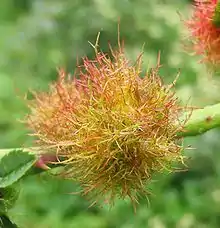 | |
| Mature gall on dog rose | |
| Scientific classification | |
| Kingdom: | Animalia |
| Phylum: | Arthropoda |
| Class: | Insecta |
| Order: | Hymenoptera |
| Family: | Cynipidae |
| Genus: | Diplolepis |
| Species: | D. rosae |
| Binomial name | |
| Diplolepis rosae | |
| Synonyms | |
| |
A similar gall is caused by Diplolepis mayri, but this is much less common.
Names
Being so prominent and interesting in appearance, this gall has more folklore attached to it than most. The term 'Bedeguar, Bedegar or Bedequar' comes from a French word, bédégar, and is ultimately from the Persian, bād-āwar, meaning 'wind-brought'.[3] Robin in Robin's pincushion refers to the woodland sprite of English folklore, Robin Goodfellow.[4]
Description
Insect
The female is about 4 mm (0.16 in) long. Parts of the abdomen and legs are yellow-red, while the rest of the body is black.[5] The male is black and lacks the hypopygium structure which clearly identifies the species in the female. Its legs are bicoloured yellow and has a body length of about 3 mm (0.12 in).[6]
Gall
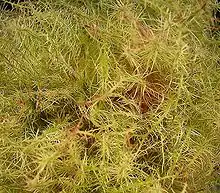
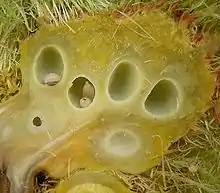
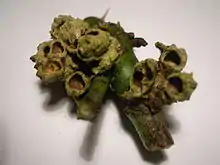
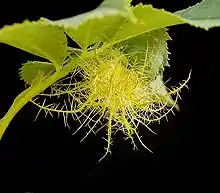
Some herbivorous insects therefore create their own microhabitats by forming, in this case, a highly distinctive plant structure called a gall, made up of plant tissue, but controlled by the insect. Galls act as both the habitat and food sources for the maker of the gall. The interior of a bedeguar gall is formed from the bud, and is composed of edible nutritious and structural tissues. Some galls act as "physiologic sinks", concentrating resources in the gall from the surrounding plant parts.[7] Galls may also provide the insect with some physical protection from predators.[8]
The bedeguar gall is surrounded by a dense mass of sticky branched filaments. This structure gives the appearance of a ball of moss, and its filaments are often brightly coloured, being at their best around September; starting off green and then passing through pink and crimson to reddish brown. A large specimen can be up to 10 cm (4 in) in width. The larvae develop and then overwinter as pupae in the now brown and dry-looking structure, emerging in May.[9] The unilarval chambers are set in a woody core which persists after the filaments have worn off.[10]
The bedeguar may also develop on Rosa rubiginosa, R. dumalis, or R. rubrifolia.[1]:156[6][10]:46
The gall induced by D. mayri differs in being more sparsely covered in short, unbranched filaments and the galls usually develop on the twigs.[4]
Lifecycle
A week after the egg has been laid, the larva hatches and begins to feed on the leaf bud tissue. This activity stimulates (in a way not yet understood) the development by the host plant of enlarged 'nutritive' cells in the area around the growing larva. These are fed on by the larva and are continually replaced by new cells. Further concentric layers of tissues develop around the core nutritive tissue and come to form the structure known as the bedeguar, complete with the outermost and characteristic fibrous outgrowths that give the gall its alternative name of Robin's pincushion. As the larva feeds and grows within this gall, it probably undergoes five larval instar stages (the growth stages between moults). The final instar stage is reached by late October. The larva ceases feeding. It now passes into the prepupal stage, in which form it overwinters inside the gall. In the following February or March, the prepupa undergoes a final moult and becomes a pupa. Through the thin, transparent skin of the pupa, it is possible to see the fully formed antennae, legs, wings and body segments of the adult wasp. As stated earlier, the adult wasps which start to emerge from the rose bedeguar will be mostly female, and these females will go on to lay eggs through parthenogenesis.[9] The adults begin to emerge from the old galls, which are still attached to the rose, in May. Emergences may continue through to August. No alternation of generations exists in this species.
As stated, males are known, but are very rare.[11][12] One possible reason for this scarcity is the presence of a bacterium in the genus Wolbachia, which is endosymbiotic in the females' gametes.[13] A female infected with Wolbachia produces only diploid eggs, when in the cells of the ovaries presumably cause the fusion of the pronuclei, which leads to entirely female progeny. When the females were treated with antibiotics, they were then able to produce normal male and female eggs.[6]
Predators, inquilines, parasites, hyperparasites and fungi
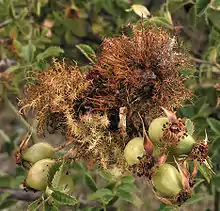
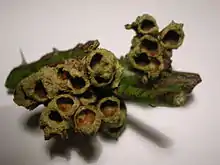
Mature galls are sometimes broken open by vertebrate predators to recover the larvae or pupae. The large size of the emergence holes of the individual cells sometimes suggests predation by birds or small mammals has taken place.[14]
The bedeguar is a good example of a complex community of insects.[15][16][17] The cynipid wasp Periclistus brandtii is an inquiline that lives harmlessly within the bedeguar gall and like Diplolepis rosae itself, is often parasitised by insects referred to as parasitoids or even by hyperparasitoids in some cases.[18]
The gall-wasp Periclistus brandtii causes no gall itself, but deposits its eggs in the bedeguar tissues on which the larvae feed. In turn, these larvae may be parasitised by a chalcid wasp, Eurytoma rosae, which works its way from one inquiline's cell to the next. The parasitoid ichneumon Orthopelma mediator lays its eggs directly into larvae of D. rosae, killing them. The chalcid wasps Eurytoma rosae and Glyphomerus stigma can attack both the larvae of D. rosae and of the inquiline P. brandtii. These parasitoids may in turn be attacked by hyperparasitoids such as the chalcids Caenacis inflexa and Pteromalus bedeguaris. The mossy and sticky filaments of the gall are clearly ineffective in preventing the entry of inquilines, predators, parasitoids and hyperparasitoids.[19]
The tissues of the bedeguar gall are frequently attacked by the parasitic fungus Phragmidium subcorticum, more so than the other parts of the host rose plant.
Infestations
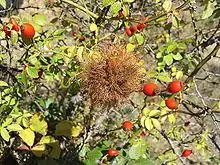
The galls occur more commonly on plants under stress, i.e. very dry conditions, waterlogging or hedge cutting, whereas vigorously growing plants are less commonly found to have galls. Whether the vigorous plant suppresses gall formation or is avoided by the wasp in favour of easier targets is unknown. Young and damaged plants tend to produce larger and more numerous galls than old and intact ones. In the latter, many eggs are laid, but the number of galls formed is relatively few.
The relative number of parasitoids decreases with increasing gall volume.[20] And the closer the gall is to the ground, the greater the total number of adults that emerge. Thus, it seems more effective for a female D. rosae to induce larger galls on lower branches of the shrubs to increase the survival probability of the offspring. The distances from margins of shrubs, however, affects neither the parasitoid ratio of galls nor the volume of the galls.[6]
Removing and destroying galls before they dry and the wasps emerge may help to reduce the infestation. While fairly large, and sometimes present in quite large numbers on scrub specimens, they cause no measurable harm.
Medicinal uses
Dried and powdered, the gall was used to treat colic,[6] as a diuretic, and as a remedy against toothache; the ashes mixed with honey and applied to the scalp were thought to prevent baldness.[21] It was also valued as an astringent and for its ability to control fluid loss; placed beneath a pillow, it was thought to induce sleep.[22]
References
- Darlington, Arnold (1975) The Pocket Encyclopaedia of Plant Galls in Colour. Pub. Blandford Press. Poole. ISBN 0-7137-0748-8. P. 133 - 135.
- "A Nature observers Scrapbook". Bugsandweeds.co.uk. Retrieved 2012-02-04.
- "Hymenopteran: gall Wasps". Gwydir.demon.co.uk. Retrieved 2012-02-04.
- Darlington, Arnold (1975) The Pocket Encyclopaedia of Plant Galls in Colour. Pub. Blandford Press. Poole. ISBN 0-7137-0748-8. P. 135.
- "Village Garden Web". Forums.gardenweb.com. Retrieved 2012-02-04.
- "Bedeguar Gall". Hedgerowmobile.com. Retrieved 2012-02-04.
- Larson, K. C.; Whitham, T. G. (1991). "Manipulation of food resources by a gall-forming aphid: the physiology of sink-source interactions". Oecologia. 88 (1): 15–21. Bibcode:1991Oecol..88...15L. doi:10.1007/bf00328398. PMID 28312726. S2CID 25722868.
- Weis, A. E.; Kapelinski, A. (1994). "Variable selection on Eurosta's gall size. II. A path analysis of the ecological factors behind selection". Evolution. 48 (3): 734–745. doi:10.2307/2410482. JSTOR 2410482. PMID 28568264.
- Darlington, Arnold (1975) The Pocket Encyclopaedia of Plant Galls in Colour. Pub. Blandford Press. Poole. ISBN 0-7137-0748-8. P. 133.
- Stubbs, F. B. Edit. (1986) Provisional Keys to British Plant Galls. Pub. Brit Plant Gall Soc. ISBN 0-9511582-0-1. P. 56.
- Rizzo, Maria Concetta; Massa, Bruno (2006). "Parasitism and sex ratio of the bedeguar gall wasp Diplolepis rosae (L.)(Hymenoptera: Cynipidae) in Sicily (Italy)" (PDF). Journal of Hymenoptera Research. 15 (2): 277–285.
- László, Zoltán; Tóthmérész, Béla (2011). "Parasitism, phenology and sex ratio in galls of Diplolepis rosae" (PDF). Entomologica Romanica. 16: 33–38.
- Schilthuizen, Menno; Stouthamer, Richard (1998). "Distribution of Wolbachia among the guild associated with the parthenogenetic gall wasp Diplolepis rosae". Heredity. 81 (3): 270–274. doi:10.1046/j.1365-2540.1998.00385.x. S2CID 21062862.
- László, Zoltán; Sólyom, Katalin; Prázsmári, Hunor; Barta, Zoltán; Tóthmérész, Béla (2014). "Predation on rose galls: parasitoids and predators determine gall size through directional selection". PLOS ONE. 9 (6): e99806. Bibcode:2014PLoSO...999806L. doi:10.1371/journal.pone.0099806. PMC 4053394. PMID 24918448.
- Randolph, Simon (2005). The natural history of the Rose Bedeguar gall and its insect community. British Plant Gall Society. ISBN 978-0951158227.
- László, Zoltán; Rákosy, László; Tóthmérész, Béla (2018). "The simpler the better: when decreasing landscape complexity increases community stability". Ecological Indicators. 84 (1): 828–836. doi:10.1016/j.ecolind.2017.09.054.
- Sudhaus, Walter (2018). "The bedeguar gall community: producer, inquilines, predators, parasitoids, hyperparasitoids and successori [in German]". Sitzungsberichte der Gesellschaft Naturforschender Freunde zu Berlin. Neue Folge. 53: 59–82. doi:10.25671/GNF_Sber_NF_53_04 (inactive 2021-01-18).CS1 maint: DOI inactive as of January 2021 (link)
- László, Zoltán; Tóthmérész, Béla (2006). "Inquiline effects on a multilocular gall community" (PDF). Acta Zoologica Academiae Scientiarum Hungaricae. 52 (4): 373–383.
- Darlington, Arnold (1975) The Pocket Encyclopaedia of Plant Galls in Colour. Pub. Blandford Press. Poole. ISBN 0-7137-0748-8. P. 134 - 135.
- László, Zoltán; Tóthmérész, Béla (2013). "The Enemy Hypothesis: correlates of gall morphology with parasitoid attack rates in two closely related rose cynipid galls". Bulletin of Entomological Research. 103 (3): 326–335. doi:10.1017/S0007485312000764. PMID 23217451. S2CID 27671718.
- Pereira, Jonathan (1842). Pereira, Jonathan. The Elements of Materia Medica and Therapeutics, pp. 1556–7. Retrieved 2012-02-04.
- "Medicinal Use of Rose Bedeguar". Retrieved 2012-02-04.
External links
- Rose Bedegaur or Robin's Pincushion video
- Video footage of Scottish galls
- "Gall". Infoplease encyclopedia. Retrieved March 2006. Check date values in:
|access-date=(help) - Photographs of the gall wasp and gall